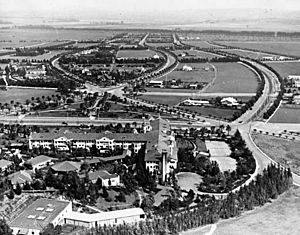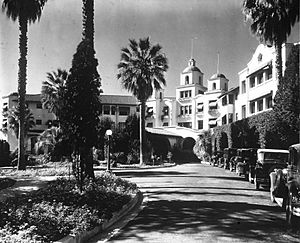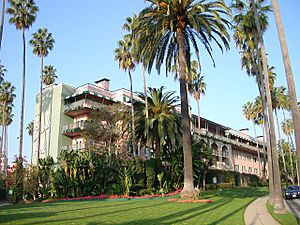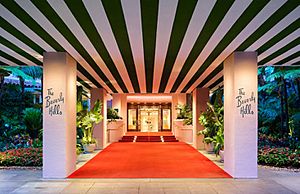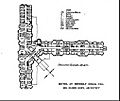The Beverly Hills Hotel facts for kids
Quick facts for kids The Beverly Hills Hotel |
|
|---|---|
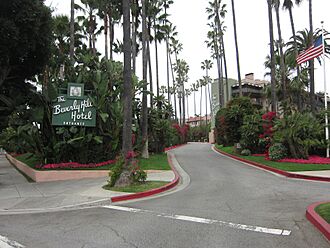
The entrance to the hotel
|
|
| General information | |
| Status | Complete |
| Type | Hotel |
| Architectural style | Mediterranean Revival |
| Address | 9641 Sunset Boulevard |
| Town or city | Beverly Hills, California |
| Country | United States |
| Coordinates | 34°4′53.17″N 118°24′49.29″W / 34.0814361°N 118.4136917°W |
| Opened | May 12, 1912 |
| Owner | Dorchester Collection |
| Design and construction | |
| Architect | Elmer Grey |
| Developer | Margaret and Stanley Anderson |
| Awards and prizes |
When using template {{Michelin stars|?}}, please add the number When using template {{Michelin stars|?}}, please add the number When using template {{Michelin stars|?}}, please add the number |
| Designations | City of Beverly Hills Historic Landmark |
| Renovating team | |
| Architect | Paul R. Williams (1940s) |
| Other information | |
| Number of rooms | 210 rooms 23 bungalows |
| Number of restaurants | 4 (Bar Nineteen12; Cabana Cafe; Fountain Coffee Room; Polo Lounge) |
| Facilities | Spa, swimming pool |
| Parking | Valet parking |
The Beverly Hills Hotel, also known as the Beverly Hills Hotel and Bungalows, is a famous hotel located on Sunset Boulevard in Beverly Hills, California. It is known worldwide and has a strong connection to Hollywood movie stars, rock stars, and other famous people. The hotel has 210 guest rooms and suites, plus 23 special bungalows. Its outside walls are painted in the hotel's signature pink and green colors.
The Beverly Hills Hotel first opened in May 1912, even before the city of Beverly Hills was officially created. Margaret J. Anderson, a wealthy widow, and her son, Stanley S. Anderson, were the original owners. The hotel was designed by architect Elmer Grey in a style called Mediterranean Revival. Over the years, many different owners have managed the hotel. In 1941, Hernando Courtright bought the hotel with friends, including famous actors Irene Dunne and Loretta Young. Courtright created the Polo Lounge, which became a popular dining spot for celebrities like the Rat Pack and Humphrey Bogart. The hotel was first painted its famous pink color in 1948.
From 1958 to 1979, Ben L. Silberstein owned the hotel. Later, in 1986, Marvin Davis bought it, and then sold it to the Sultan of Brunei less than a year later. The hotel closed for a big renovation in 1992 and reopened in 1995. Since 1996, it has been part of the Dorchester Collection of hotels. In 2012, the hotel was recognized as the first historic landmark in Beverly Hills.
The famous song "Hotel California" by the band Eagles is partly inspired by stories about this hotel. A picture of the hotel is even on the cover of their album, Hotel California.
Contents
History of the Pink Palace
How the Hotel Began
In 1911, Margaret J. Anderson and her son, Stanley S. Anderson, decided to build the Beverly Hills Hotel. They chose a spot near the home of Burton E. Green, a rich oil and real estate developer. Green owned a lot of land in the Santa Monica Mountains and wanted to attract people to the area. He thought a hotel would help sell the mansions he was building. He named the area "Beverly Farms" after his home.
The Los Angeles Times announced in May 1911 that Anderson would build a "huge Mission-style hotel." It promised that guests would get "the best of everything."
The hotel opened on May 12, 1912, before Beverly Hills was even a city. Margaret and Stanley lived at the hotel. By 1914, many Hollywood stars like Mary Pickford, Douglas Fairbanks, and Charlie Chaplin bought homes nearby. This turned the area around the hotel into valuable land. The city of Beverly Hills was officially created in 1914. The hotel added its first five bungalows in 1915.
In 1915, the Andersons gave some of the hotel's land to the community. This land became the first public park, now called Will Rogers Memorial Park. The hotel also had a fun tradition of an annual Easter egg hunt for children.
Silent film star Harold Lloyd filmed a scene for his movie A Sailor-Made Man at the hotel in 1921. During the Great Depression, the hotel closed for a short time, but its bungalows were still rented out. It reopened in 1932 with help from the Bank of America.
A Place for Movie Stars
In the 1930s, the Beverly Hills Hotel became very popular with Hollywood stars. Fred Astaire loved reading newspapers by the pool. In 1938, the hotel opened the Sand and Pool Club, which had white sand brought in from Arizona to make it feel like a beach. This club became very popular and even hosted fashion shows. In 1940, actress Marlene Dietrich helped change a rule in the Polo Lounge that required women to wear skirts.
In 1941, Hernando Courtright and his friends, including actors Irene Dunne and Harry Warner, bought the hotel. Courtright created the Polo Lounge, named after famous polo players who celebrated there. In 1942, Howard Hughes bought several bungalows and lived there often. The hotel even delivered his favorite roast beef sandwiches to a special spot in a tree. The hotel was painted its famous pink color in 1948, earning it the nickname "the Pink Palace." Architect Paul Williams added the Crescent Wing the next year.
Many famous people enjoyed the hotel. W.C. Fields and Humphrey Bogart spent time at the bar. Katharine Hepburn once did a backflip into the pool. Elizabeth Taylor stayed in the bungalows for several of her honeymoons. The Polo Lounge was a favorite spot for Frank Sinatra and Dean Martin. In 1956, the hotel's pool was used for filming the movie Designing Woman with Gregory Peck. Marilyn Monroe often stayed in Bungalow No. 7.
In the 1970s, John Lennon and Yoko Ono stayed in one of the bungalows. In 1972, important political figures were having breakfast in the Polo Lounge when they learned about the Watergate burglary. In 1977, actor Peter Finch passed away in the hotel lobby. Later that year, the hotel's exterior was featured on the cover of the Eagles' album Hotel California.
Modern Times and Changes
After owner Ben Silberstein passed away in 1979, his daughters inherited the hotel. In 1986, Marvin Davis bought the hotel, then sold it to the Sultan of Brunei for $110 million.
On December 30, 1992, the hotel closed for a major renovation that cost over $100 million. It reopened on June 3, 1995, with many upgrades. Since 1996, the hotel has been managed by the Dorchester Collection. In 2011, Edward Mady became the general manager. In 2012, the hotel celebrated its 100th anniversary and began remodeling its lobby and other areas. It was also named the first historic landmark in Beverly Hills. In 2022, John Scanlon became the general manager.
A Big Discussion: The Boycott
In April 2014, a boycott of the hotel began. This happened because the Sultan of Brunei, who partly owns the hotel, introduced new laws in his country that many people found unfair or discriminatory. A group called the Gill Action Fund canceled their event at the hotel to protest.
Many fashion designers and celebrities, including Richard Branson, Jay Leno, and Ellen DeGeneres, supported the boycott. They encouraged people to avoid all hotels owned by the Dorchester Collection. Other organizations also canceled their events. However, some people, like Russell Crowe and Kim Kardashian, spoke against the boycott. They felt it was unfair to punish the hotel's hardworking employees.
In May 2014, the Beverly Hills City Council asked the Sultan of Brunei to sell the hotel. The mayor at the time, Lili Bosse, also decided not to visit the hotel until the situation was resolved. News reports said that over $2 million worth of events had been canceled at the hotel. The hotel's CEO, Christopher Cowdray, pointed out that many businesses have foreign owners.
In April 2019, there were new calls for a boycott when Brunei introduced more strict laws. Celebrities like George Clooney and Elton John joined the protest. The LA City Council voted to stop doing business with the hotel. The Dorchester Collection stated that they "do not tolerate any form of discrimination." In May 2019, the Sultan of Brunei said that his country would not use the death penalty for cases under the new laws. Despite this, some still asked the city to continue the boycott.
Helping During COVID-19
During the COVID-19 pandemic, the hotel stayed open. It had to reschedule many events planned for 2020. The hotel also helped the community by donating to organizations like the Children's Hospital Los Angeles. The Polo Lounge provided meals to healthcare workers at LA hospitals. The hotel even changed its famous sign to honor these frontline workers.
Hotel Design and Features
Outside the Hotel
The Beverly Hills Hotel is known for its unique look. It has been described as a "peachy pink dream dusted with gold" with green and white striped details. The original main building was designed by architect Elmer Grey in the Mediterranean Revival style. It looked like a grand white mansion with verandas and arches. The hotel was built on a hill, surrounded by countryside back then. Above the main entrance are three domes, with flags flying from them. The famous hotel sign was designed by architect Paul Williams.
The beautiful gardens cover 12 acres and were designed by Wilbur David Cook. They feature colorful bougainvillea, banana plants, and hibiscus. Svend Petersen, the hotel's pool manager for 42 years, became a Hotel Ambassador in 2002. He once opened the pool after hours for the Beatles!
Inside the Hotel
The hotel has several special rooms. The Crystal Room was used for small dinner parties. The main dining room could hold up to 500 people. The children's dining room later became the Polo Lounge. The Polo Lounge was updated in 1974 with a softer design, table lamps, and flowers. It is decorated in peachy pink with dark green booths. A photo behind the bar shows Will Rogers and Darryl F. Zanuck playing polo. The menu includes a "Neil McCarthy salad," named after a famous polo player. The hotel even has its own bakery and herb garden.
A new section, called the "Crescent Wing," was added to the east side of the main building in the late 1940s. This wing has balconies with beautiful plants. The fireplace in the hotel's lobby has a fire burning every day of the year.
Rooms and Special Bungalows
Many rooms have their own balcony and are decorated in the hotel's signature colors: pinks, greens, apricots, and yellows. Some of the more expensive rooms have private patios, hot tubs, and kitchens.
Five bungalows were first added to the gardens in 1915 for families who wanted to return each year. As of 2015, the hotel has 23 bungalows spread throughout the gardens. Bungalows 14-21 are known as "Bachelor's Row" because many film stars stayed there. In 1990, a private pool and hot tub were added to Bungalow No. 5 for businessman Walter Annenberg. This bungalow was also a favorite of Elizabeth Taylor. Marilyn Monroe liked Bungalows No. 1 and No. 7. Bungalow No. 1 is the most private. No. 7 is sometimes called "the 'Norma Jean'." Marlene Dietrich had a very large bed added to Bungalow No. 10, where John Lennon and Yoko Ono stayed in the 1970s. Bungalow No. 22 was a favorite of Frank Sinatra and later Donald Trump. In 2011, two new Presidential Bungalows were built, each with three bedrooms and a private swimming pool. A one-night stay in a bungalow can cost a lot of money.
Howard Hughes always kept a bungalow at the hotel, but it was a secret when he was there. Only the hotel's chef often knew, as Hughes would wake him up late at night for food. Some people believe that several bungalows are haunted. Guests have reported hearing what sounds like Harpo Marx playing the harp.
Gallery of historic images
See also
- Dorchester Collection
- Hotel Bel-Air



